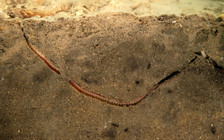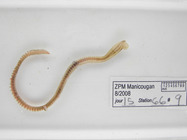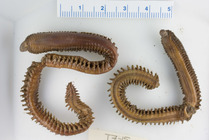Deep-Sea taxon details
Nephtys Cuvier, 1817
129370 (urn:lsid:marinespecies.org:taxname:129370)
accepted
Genus
Nephthys [variant spelling of Nephtys] · unaccepted (subsequent misspelling for...)
subsequent misspelling for original Nephtys
- Species Nephtys brachycephala Moore, 1903
- Species Nephtys bruuni Kirkegaard, 1995
- Species Nephtys caeca (Fabricius, 1780)
- Species Nephtys ciliata (Müller, 1788)
- Species Nephtys ferruginea Hartman, 1940
- Species Nephtys hystricis McIntosh, 1900
- Species Nephtys incisa Malmgren, 1865
- Species Nephtys longosetosa Örsted, 1842
- Species Nephtys paradoxa Malm, 1874
- Species Nephtys phyllocirra Ehlers, 1887
- Species Nephtys picta Ehlers, 1868
- Species Nephtys punctata Hartman, 1938
- Species Nephtys schmitti Hartman, 1938
- Species Nephtys squamosa Ehlers, 1887
- Species Nephtys yuryi Dnestrovskaya, 2017
- Species Nephtys cornuta Berkeley & Berkeley, 1945 accepted as Micronephthys cornuta (Berkeley & Berkeley, 1945) (superseded original combination (correct genus spelling))
- Species Nephtys malmgreni Théel, 1879 accepted as Aglaophamus malmgreni (Théel, 1879) (synonym)
- Species Nephtys minuta (Théel, 1879) accepted as Micronephthys minuta (Théel, 1879) (superseded recombination (strictly a subsequent generic spelling))
- Species Nephtys rubella Michaelsen, 1897 accepted as Aglaophamus agilis (Langerhans, 1880) (corrected spelling (originally as Nephthys) and subsequent subjective synonym)
- Species Nephtys sphaerocirrata (Wesenberg-Lund, 1949) accepted as Micronephthys sphaerocirrata (Wesenberg-Lund, 1949) (superseded combination)
marine, brackish, fresh, terrestrial
recent only
Cuvier, Georges L., 1817. Le règne animal distribué d'après son organisation : pour servir de base a l'histoire naturelle des animaux et d'introduction a l'anatomie comparée. VOLUME 4. Les Zoophytes, les Tables, et les Planches. Deterville, Paris., available online at http://www.biodiversitylibrary.org/item/17709
page(s): Additions & Corrections p.173 [details]
page(s): Additions & Corrections p.173 [details]
Note Type species generally said to be Nephtys...
[details]
From editor or global species database
Type species Type species generally said to be Nephtys hombergii Savigny MS in Lamarck (1818). Savigny (1822) as finally published refers to "Nephthys Hombergii. Cuv. Collect. et Règn; anim. tom. IV, pag. 173". However, N. hombergii is not mentioned at all by Cuvier (1817). Cuvier (1817) introduced in "especes de Nephtys" the following six species listed as their original names in Nereis. (Nereis ciliata [Muller, 1776 = Nephtys], Nereis stellifera [Muller, 1788 = Sigalion], Nereis alba [Muller 1776 = Glycera], Nereis maculata [Linnaeus, 1767 = Phyllodoce], Nereis crassa [Gmelin in Linnaeus, 1788 = Nereis], and 'peut-etre aussi' Nereis punctata [Müller, 1788 = Nereimyra]). Thus N. hombergii was not originally included and cannot be the type species (ICZN Art.67.2) unless it is a synonym of one of the originally included species. Only Nephtys ciliata seems eligible for type species status.[details]
Etymology If Cuvier and Lamarck derived 'Nephtys' from the mythological 'Nephthys', the spelling used by some taxonomists,...
Etymology If Cuvier and Lamarck derived 'Nephtys' from the mythological 'Nephthys', the spelling used by some taxonomists, influentially including Savigny in "Description de l'Égypte ..." (finally published 1822), then they used a variant spelling of the name adopted in Greek for an Egyptian goddess, transliterated from heiroglyphs as Nebet-het, sister of Isis and Osiris, and companion of Set (see e.g., Wikipedia on Nephthys ). [details]
Read, G.; Fauchald, K. (Ed.) (2024). World Polychaeta Database. Nephtys Cuvier, 1817. Accessed through: Glover, A.G.; Higgs, N.; Horton, T. (2024) World Register of Deep-Sea species (WoRDSS) at: https://www.marinespecies.org/deepsea/aphia.php?p=taxdetails&id=129370 on 2024-04-18
Glover, A.G.; Higgs, N.; Horton, T. (2024). World Register of Deep-Sea species (WoRDSS). Nephtys Cuvier, 1817. Accessed at: https://marinespecies.org/deepsea/aphia.php?p=taxdetails&id=129370 on 2024-04-18
Date
action
by
original description
Cuvier, Georges L., 1817. Le règne animal distribué d'après son organisation : pour servir de base a l'histoire naturelle des animaux et d'introduction a l'anatomie comparée. VOLUME 4. Les Zoophytes, les Tables, et les Planches. Deterville, Paris., available online at http://www.biodiversitylibrary.org/item/17709
page(s): Additions & Corrections p.173 [details]
additional source Glasby, Christopher J.; Read, Geoffrey B.; Lee, Kenneth E.; Blakemore, R.J.; Fraser, P.M.; Pinder, A.M.; Erséus, C.; Moser, W.E.; Burreson, E.M.; Govedich, F.R.; Davies, R.W.; Dawson, E.W. (2009). Phylum Annelida: bristleworms, earthworms, leeches. <em>[Book chapter].</em> Chapt 17, pp. 312-358. in: Gordon, D.P. (Ed.) (2009). New Zealand inventory of biodiversity: 1. Kingdom Animalia: Radiata, Lophotrochozoa, Deuterostomia. Canterbury University Press, Christchurch. [details] Available for editors
additional source Fauchald, K. (1977). The polychaete worms, definitions and keys to the orders, families and genera. <em>Natural History Museum of Los Angeles County: Los Angeles, CA (USA), Science Series.</em> 28:1-188., available online at http://www.vliz.be/imisdocs/publications/123110.pdf [details]
additional source Bellan, G. (2001). Polychaeta, <i>in</i>: Costello, M.J. <i>et al.</i> (Ed.) (2001). European register of marine species: a check-list of the marine species in Europe and a bibliography of guides to their identification. <em>Collection Patrimoines Naturels.</em> 50: 214-231. (look up in IMIS) [details]
additional source Day, J. H. (1967). [Errantia] A monograph on the Polychaeta of Southern Africa. Part 1. Errantia. British Museum (Natural History), London. pp. vi, 1–458, xxix., available online at http://www.biodiversitylibrary.org/bibliography/8596 [details]
identification resource Dixon-Bridges, Kylie; Gladstone, William; Hutchings, Patricia A. (2014). One new species of <em>Micronephthys</em> Friedrich, 1939 and one new species of <em>Nephtys</em> Cuvier, 1817 (Polychaeta: Phyllodocida: Nephtyidae) from eastern Australia with notes on <em>Aglaophamus</em> <em>australiensis</em> (Fauchald, 1965) and a key to all Australian species. <em>Zootaxa.</em> 3872(5): 513-540., available online at https://doi.org/10.11646/zootaxa.3872.5.5
page(s): 531 [tabulation of Australian and Indo-pacific species of Nephtys]] [details] Available for editors
identification resource Hossain, M. Belal; Hutchings, Pat. (2016). <em>Nephtys bangladeshi</em> n. sp., a new species of Nephtyidae (Annelida: Phyllodocida) from Bangladesh coastal waters. <em>Zootaxa.</em> 4079(1): 41-52., available online at http://biotaxa.org/Zootaxa/article/view/zootaxa.4079.1.3
page(s): 48; note: Table of Indo-Pacific Nephtys species [details]
page(s): Additions & Corrections p.173 [details]
additional source Glasby, Christopher J.; Read, Geoffrey B.; Lee, Kenneth E.; Blakemore, R.J.; Fraser, P.M.; Pinder, A.M.; Erséus, C.; Moser, W.E.; Burreson, E.M.; Govedich, F.R.; Davies, R.W.; Dawson, E.W. (2009). Phylum Annelida: bristleworms, earthworms, leeches. <em>[Book chapter].</em> Chapt 17, pp. 312-358. in: Gordon, D.P. (Ed.) (2009). New Zealand inventory of biodiversity: 1. Kingdom Animalia: Radiata, Lophotrochozoa, Deuterostomia. Canterbury University Press, Christchurch. [details] Available for editors
additional source Fauchald, K. (1977). The polychaete worms, definitions and keys to the orders, families and genera. <em>Natural History Museum of Los Angeles County: Los Angeles, CA (USA), Science Series.</em> 28:1-188., available online at http://www.vliz.be/imisdocs/publications/123110.pdf [details]
additional source Bellan, G. (2001). Polychaeta, <i>in</i>: Costello, M.J. <i>et al.</i> (Ed.) (2001). European register of marine species: a check-list of the marine species in Europe and a bibliography of guides to their identification. <em>Collection Patrimoines Naturels.</em> 50: 214-231. (look up in IMIS) [details]
additional source Day, J. H. (1967). [Errantia] A monograph on the Polychaeta of Southern Africa. Part 1. Errantia. British Museum (Natural History), London. pp. vi, 1–458, xxix., available online at http://www.biodiversitylibrary.org/bibliography/8596 [details]
identification resource Dixon-Bridges, Kylie; Gladstone, William; Hutchings, Patricia A. (2014). One new species of <em>Micronephthys</em> Friedrich, 1939 and one new species of <em>Nephtys</em> Cuvier, 1817 (Polychaeta: Phyllodocida: Nephtyidae) from eastern Australia with notes on <em>Aglaophamus</em> <em>australiensis</em> (Fauchald, 1965) and a key to all Australian species. <em>Zootaxa.</em> 3872(5): 513-540., available online at https://doi.org/10.11646/zootaxa.3872.5.5
page(s): 531 [tabulation of Australian and Indo-pacific species of Nephtys]] [details] Available for editors
identification resource Hossain, M. Belal; Hutchings, Pat. (2016). <em>Nephtys bangladeshi</em> n. sp., a new species of Nephtyidae (Annelida: Phyllodocida) from Bangladesh coastal waters. <em>Zootaxa.</em> 4079(1): 41-52., available online at http://biotaxa.org/Zootaxa/article/view/zootaxa.4079.1.3
page(s): 48; note: Table of Indo-Pacific Nephtys species [details]
 Present
Present  Inaccurate
Inaccurate  Introduced: alien
Introduced: alien  Containing type locality
Containing type locality
From editor or global species database
Etymology If Cuvier and Lamarck derived 'Nephtys' from the mythological 'Nephthys', the spelling used by some taxonomists, influentially including Savigny in "Description de l'Égypte ..." (finally published 1822), then they used a variant spelling of the name adopted in Greek for an Egyptian goddess, transliterated from heiroglyphs as Nebet-het, sister of Isis and Osiris, and companion of Set (see e.g., Wikipedia on Nephthys ). [details]Habitat Open softshore beaches, but also offshore to deepsea [details]
Spelling Cuvier first edition "Le Règne Animal ..." (1817 vol.4, p.173) introduces Nephtys, and Lamarck (1818:314) follows that spelling, whether or not it is the same as in Savigny's MS, whereas subsequent 1830 and 1836 editions of Cuvier use the spelling Nephthys as in the Greek form of the name. As finally published Savigny's "Description de l'Égypte ..." (1822) has the Nephthys form. The spelling Nephtys as first published must be followed, and for example Quatrefages (1866:420) adheres to that spelling. But others did not. Prevailing usage today follows the original spelling. [details]
Type species Type species generally said to be Nephtys hombergii Savigny MS in Lamarck (1818). Savigny (1822) as finally published refers to "Nephthys Hombergii. Cuv. Collect. et Règn; anim. tom. IV, pag. 173". However, N. hombergii is not mentioned at all by Cuvier (1817). Cuvier (1817) introduced in "especes de Nephtys" the following six species listed as their original names in Nereis. (Nereis ciliata [Muller, 1776 = Nephtys], Nereis stellifera [Muller, 1788 = Sigalion], Nereis alba [Muller 1776 = Glycera], Nereis maculata [Linnaeus, 1767 = Phyllodoce], Nereis crassa [Gmelin in Linnaeus, 1788 = Nereis], and 'peut-etre aussi' Nereis punctata [Müller, 1788 = Nereimyra]). Thus N. hombergii was not originally included and cannot be the type species (ICZN Art.67.2) unless it is a synonym of one of the originally included species. Only Nephtys ciliata seems eligible for type species status.
[details]
| Language | Name | |
|---|---|---|
| English | shimmy wormsRed-lined wormcatworms | [details] |
| German | Opalwürmer | [details] |
| Russian | Нефтис | [details] |











